Archive Record
Images
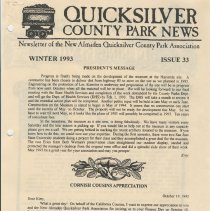
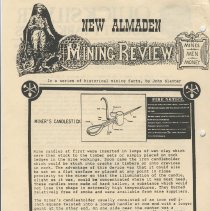
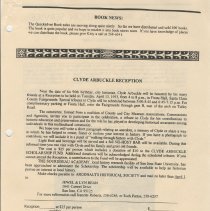
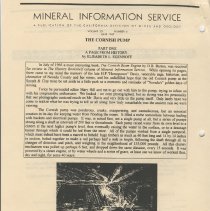
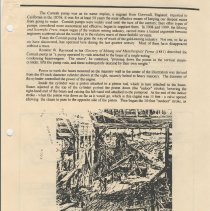
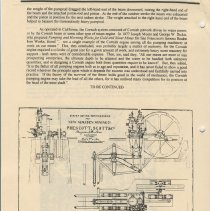
Additional Images [6]
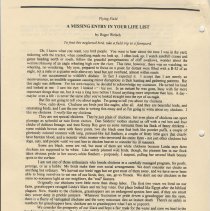
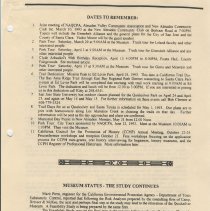
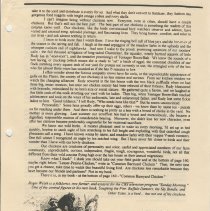
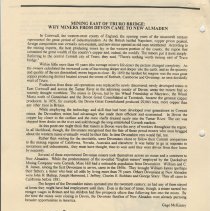

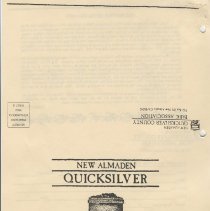
Metadata
Catalog number |
1997.2.2605 |
Object Name |
Newsletter |
Date |
1993 |
Description |
TITLE: Quicksilver County Park News SUBTITLE: Newsletter of the New Almaden Quicksilver County Park Association Issue # 31 Winter 1993 PRESIDENT'S MESSAGE ISSUE 33 Progress is finally being made on the development of the museum at the Hacienda site. A contractor has been chosen to deliver dirt from highway 85 to store on the site as we planned in 1985 Engineering on the protection of Los Alamitos is underway and preparation of the site will be in progress from now until October when all the material will be in place. We will be looking forward to our final meeting with the State Health Services and completion of the work demanded by the County Parks Dept and will go the Dept. of Health Services (DHS) by Feb. I, 1993. The DHS will take a month to renew it and the remedial action plan will be completed. Another public input will be held in late May or early June. Construction on the Museum is slated to begin in May of 1994. It seems that no construction can start until the months of May to October. The property will not be ready for development this May. So we have to wait till next May, so it looks like the plans of 1985 will possibly be completed in 1995. Ten years of consultant fees In the meantime, the museum as it sits now, is doing fabulously. We have many visitors every Saturday and the tour season is picking up. If you would like to help out at the museum in any capacity please give me a call. We are getting behind in marking the recent artifacts donated to the museum. If you know how to do this, we could sure use your expertise. During the first semester, there were two San Jose State University students doing a project for their class and they accomplished a great deal for the museum. The two Erics from Beth Wyman's preservation class straightened our outdoor display, sanded and protected the manager's desktop from the original mine office and did a splendid slide show of their work. May 1993 be a great year for your association and may you prosper. Kitty CORNISH COUSINS APPRECIATION October 19, 1992 Dear Kitty, What a great day! On behalf of the California Cousins, 1 want to express our appreciation to you and the New Almaden Quicksilver Park Association for inviting us to your Pioneer Day on October 10. Being able to view firsthand the home ground of some of our families made it a memorable time - not to mention that delicious barbecue! We also want to thank you, personally, for all your efforts to save this historic area for all Americans. We and future generations owe you a great debt. Sincerely, Joe Roberts, President California Cornish Cousins MINING REVIEW In a series of historical mining facts, by John Slenter MINER'S CANDLESTICK Mine candles at first were inserted in lumps of wet clay which were then stuck to the timber sets or simply placed on rock ledges in the mine workings. Soon came the iron candleholder which could be stuck into cracks in timbers or into crevices in rock. The advantage of this device was that it could also be set on a flat surface or placed at any point in close proximity to the miner so that the illumination of the candle, slight as it was, could be concentrated where it was most need. These candles were made of hard tallow, a substance which would not lose its shape in extremely high temperatures. They burned relatively free of smoke and were available from mine suppliers. The miner's candleholder usually consisted of an iron rod ;1/4 inch square twisted into a looped handle at one end with a longer point at the other end. On one side near the center was a spring-clip thimble for securely holding the candles. Opposite the clip, rising at right angles to the rod, was a hook. All early one-piece devices were hammered out of a single rod by a blacksmith. Later when they became more popular they were manufactured commercially in quantities and most mining-supply catalogs listed miner's candles and holders. This device is probably the most romantic article to be found in the history of pre-electric underground mine lighting. Good luck and fortune were supposed to have followed certain "lucky" candlesholders BOOK NEWS: The Quicksilver Book sales are moving along quite nicely. So far we have distributed and sold 400 books. The book is quite popular and we hope to market it into book stores soon. If you have knowledge of places - we can distribute the book, please give Kitty a call at 268-6541. CLYDE ARBUCKLE RECEPTION Near the date of his 90th birthday, city historian, Clyde Arbuckle will be honored by his many friends at a Reception to be held on Tuesday, April 13, 1993, from 4 to 8 p.m., in Fiesta Hall, Santa Clara County Fairgrounds. Special tributes to Clyde will be scheduled between 5:00-5:45 and 6:45-7:15 p.m. For complimentary parking at Fiesta Hall, enter the Fairgrounds through gate B, east of the arch on Tulley Road. The committee, formed from a coalition of County and City Museum Associations, Commissions and Agencies, invites you to participate in the celebration, a tribute to Clyde for his contributions to historic education and preservation and for the role he has played in developing historical awareness among individuals in this multicultural community. We hope you will write a short paragraph relating an anecdote, a memory of Clyde or share a way in which he has helped to create, foster or nurture your interest in history. If you have a photograph to contribute, we will include it in a panel of "walking through history with Clyde." Light food and beverage will be served and a full NO-HOST BAR will be available. During this informal time you can visit with Clyde and his family and greet old friends. The cost is $25 per person which includes a donation of $10 to the CLYDE ARBUCKLE SCHOLARSHIP FUND. Additional donations will be acknowledged during the scheduled tributes. If you cannot attend the Reception, a contribution to the Fund will be appreciated. THE SOURISSEAU ACADEMY, local history research facility of San Jose State University, has been approached to administer the Scholarship. The scholarship will be available to help an historian pursue an interest in local history. Make checks payable to: ARGONAUTS HISTORICAL SOCIETY and mail no later than april I to JEWEL & LYN BEAN 1641 Carmel Drive San Jose, CA 95125 For more information call Jeanette Roberts, 258-4286, or Ruth Patton, 258-6257. Reception at $25 per person $ number Scholarship only $ $ Total enclosed $ Name(s) Address Enclosures: letter photograph MINERAL INFORMATION SERVICE A PUBLICATION OF THE CALIFORNIA DIVISION OF MINES AND GEOLOGY VOLUME 70 NUMBER 6 JUNE 1967 THE CORNISH PUMP PART ONE A PAGE FROM HISTORY.. by ELISABETH L. EGENHOFF In July of 1966 a most interesting book, The Cornish Beam Engine by D B. Barton, was received for review in The History Bookshelf column of Mineral Information Service. While opening its pages, there came to my mind the memory of the late H.P"Horsepower' Davis, venerable sage, historian, and chronicler of Nevada County and her mines, and his unfulfilled hope that the old Cornish pump at the Sneath & Clay mine be set aside in a little park as a memento and reminder of "Nevada's" golden days of mining. Twice he persuaded editor Mary Hill and me to go out with him to the pump, trying to infuse us with his irrepressible enthusiasm. We looked - we even photographed; but so strong was his personality that our photographs centered much on Mr. Davis and very little on the pump itself. Only lately have we come to realize what he was trying to tell us all along: how truly remarkable was the ancient ruin we were viewing. The Cornish pump was ponderous, creaky, exasperating, and cantankerous, but an essential creation in its day for keeping water from flooding the mines. It filled a niche somewhere between bailing with buckets and electrical pumps. It was, in actual fact, not a single pump at all, but a series of pumps strung along a shaft at intervals of 200 feet or thereabouts. Each pump raised water from its own level to a cistern at the next higher pump's level, thus eventually raising the water to the surface, or to a drainage tunnel through which it could be led from the mine. All of the pumps worked from a single pump rod. which must indeed have been a marvel to behold: huge timbers as much as 60 feet long and 14 by 14 inches in section, bolted together to make a rod perhaps half a mile in length, following the shaft through all its changes of direction and pitch, and weighing in the neighborhood of 135,000 pounds. All this clumsy mechanism was pulled up perhaps 6 feet, arid dropped down the same distance, every 15 seconds. It was powered by a steam engine, or by water wheels and a series of gears; at least one we know of worked thus. Day and night for some 40 years. The Cornish pump was as its name implies, a migrant from Cornwall, England, imported to California in the 1850s, it was for at least 50 years the most effective means of keeping our deepest mines from going to water. Cornish pumps were widely used until the turn of the century; then other types of pumps, considered more economical and effective, began to supplant them. In 1908 and 1909, the Mining and Scientific Press, major organ of the western mining industry, carried many a heated argument between engineers scattered about the world as to the relative merit of those faithful servants Today the Cornish pump has gone the way of much of the gold-mining industry. Not one, so far as we have discovered, has operated here during the last quarter century. Most of them have disappeared without a trace. Rossiter W. Raymond in his Glossery of Mining and Metallurgical Terms (1881) described the Cornish pump as "a pump operated by rods attached to the beam of a single-acting condensing beam-engine. The steam', he continues, "pressing down the piston in the vertical steam cylinder, lifts the pump rods, and these subsequently descend by their own weight." Power to work the beam mounted on the masonry wall in the center of the illustration was derived from the 85-inch diameter cylinder shown at the right, securely bolted to heavy masonry. The diameter of the cylinder controlled the power of the engine Inside the cylinder was a piston attached to a piston rod, which in turn attached to the beam. Steam injected at the top of the cylinder pushed the piston down (the "indoor" stroke), lowering the right-hand end of the beam and raising the left-hand end attached to the pump rod. At the end of the indoor stroke - when the piston was down as far as it would go, which in this engine was I1 feet - a valve opened allowing the steam to pass to the opposite side of the piston. Then began the 10-foot "outdoor" stroke, as the weight of the pump rod dragged the left-hand end of the beam downward, raising the right-hand end of the beam and the attached piston-rod and piston. At the end of the outdoor stroke the steam was exhausted and the piston in position for the next indoor stroke. The weight attached to the right-hand end of the beam helped to balance the tremendously heavy pump rod. As operated in California, the Cornish system consisted of Cornish pitwork driven by water power, or by the Cornish beam or some other type of steam engine. In 1877 Joseph Moore and George W Dickie, who prepared Pumping and Hoisting Works for Gold and Silver Mines for San Francisco's famous Risdon Iron Works, found "... not a single example of the Cornish engine among all the pumping machinery at work on our mines." This they concluded, was probably largely a matter of economy, for the Cornish engine required a cylinder of great size for a given amount of work, and extremely heavy stone masonry for support - both items were of considerable expense. Then, too, said they, "All our mines are more or less prospecting enterprises, the ultimate depth to be attained and the water to be handled both unknown quantities; and in designing a Cornish engine both these quantities require to be known". But, they added, It is the father of all pumping engines both as to age and reputation, and it has never failed to show a good record wherever the principle upon which it depends for success was understood and faithfully earned into practice. If the theory of the survival of the fittest holds good in the world of mechanics, the Cornish pumping engine may take the lead of all the others, for it has outlived many competitors for its position at the head of the mine shaft." Cornish pump at the Gold Hill mine, Grass Valley This sketch was created by George Mathis, and "'first published, in color, for Alpha Hardware Company, on its' Gold Hill Calendar' The first lode gold discovery in the state was supposedly made at Gold Hill at Grass Valley in Nevada County in the year 1850 The mine workings have long since disappeared, but a monument has been erected to mark the.area, Melville Attwood one of the foremost Mining engineers of gold rush days, wrote of this pump for William A. Byrnes Direcrory of Grass Valley Township for 1865, "The first Cornish pump used in this State was put in the Gold Mill mine in 1855, and the castings were made at a small foundry which I put up near the mill They were probably the first foundry work done in the mountains TO BE CONTINUED DATES TO REMEMBER: I. Joint meeting of NAQCPA, Almaden Valley Community Association and New Almaden Community Club Inc March 10, 1993 at the New Almaden Community Club on Bertram Road at 7 OOPM Topics will include the Greenbelt Alliance and the general plans for the City of San Jose and the County of Santa Clara. Vickie Moore wall be the guest speaker 2 Park Tour. Saturday, March 20 at 9 OOAM at the Museum Truck tour for Leland faculty and other interested people. 3 Park Tour Saturday, April 3 at 9 OOAM at the Museum Truck tour for Greenbelt Alliance and any other interested people. 4 Clyde Arbuckle's 90th Birthday Reception, April 13 4 OOPM to 8 OOPM, Fiesta Hall, County Fairgrounds. See enclosed article 5 Park Tour Saturday, April 17 at 9 30AM at the Museum. Truck tour for Gems and Minerals and other interested people. 6 Trail Dedication Mission Peak to Ed Levin Park. April 24, 1993. This date is California Trail Day The Bay Area Ridge Trail through East Bay Regional Park District connecting to Santa Clara Park System at Ed Levin Park will be completed that morning with trail work starting at 9 OOAM at Ed Levin Park. The dedication and lunch will be from 12.00 to 3:OOPM. If you are interested in Joining us in this dedication call Kitty at 268-6541. 7 San Jose State University has outdoor classes planned for the Quicksilver Park on April 24 and April 25, and again on May 14 and May 15. For further information on these events call Bob Clement at 408-779-3524 8 Trail Days for us at Quicksilver and Santa Teresa is scheduled for May 1, 1993 Our plans are to join with homeowners along Los Alamitos Creek in cleaning the trails on that day Further information will be sent as the day approaches and plans are confirmed. 9. Memorial Day Picnic in New Almaden. Monday, May 31 from 12:00 Noon. 10. Park Tour City Tours sponsored by NAQCPA, June 12, 1993. Meet at the Museum IO OOAM to l:OOPM. Then visit the Museum. II California Council for the Promotion of History (CCHP) Annual Meeting, October 22-24 Preconference workshops and reception October 21. Free workshops focusing on the application process for CCPH mini-grants, oral history interviewing for beginners, history museums, and the CCPH Register of Professional Historians. More information later. MUSEUM STATUS - THE STUDY CONTINUES Mark Piros, engineer for the California Environmental Protection Agency - Department of Toxic Substances Control, reported that following the Risk Analysis prepared by the consulting firm of Camp, Dresser & McKee, the next and perhaps final step in the study may lead to the relocation of the Quicksilver Museum A Feasibility Study is being prepared by the same firm. The Feasibility Study may be the final step in the process before work actually begins. The study should present several options on mitigating any problems which are perceived to exist. The most desirable mitigation method will be selected after a public meeting(s) which probably will be held in June or July 1993 It appears that soil will be moved from the freeways 85 and 87 projects to provide cover for the area selected for the museum site. Richard Wachs Flying Field A MISSING ENTRY IN YOUR LIFE LIST by Roger Welsch To find this neglected bird, take afield trip to a farmyard. Oh, 1 know what you want, you bird people. You want to hear about the time I was in the yard, tinkering with the tractor, when something made me look up. 1 often look up; I watch sandhill cranes and geese heading north or south, follow the graceful peregrinations of cliff swallows, wonder about the weltanschauung of an eagle wheeling high over the river. This time, however, there was no watching, no wheeling, no wondering. My eyes, prepared to focus on a point far distant were filled with a B-52 of an eagle, not a mile or a quarter mile above my head but just overhead, almost within reach. 1 am accustomed to wildlife's disdain. In fact I expected it. I accept that I am merely an inconvenience, an inedible organism causing minor disruptions in their hunting and gathering patterns. But this eagle was different. For his own reasons, he decided to acknowledge my existence. He turned his head and looked at me. I saw his eye; I looked into his eye. In an instant he was gone, busy with far more important things than me, but it was a long time before I found anything more important than him. A day -maybe even a life - is never the same after you've looked straight into the eye of an eagle. But I'm not going to tell you about eagles. I'm going to tell you about my chickens. Now, calm down. Chickens are birds just like eagles, after all. And they are beautiful birds, and interesting birds, and 1 am the one who is writing this essay and so I'm going to write about my chickens. I like my chickens. I really like my chickens. They are not special chickens. They're just plain of chickens, but even plain of chickens can sport plumage as splendid as rain forest exotics. Dan Selden's' mother started us off with a red hen and four chicks of dubious lineage, and then Kenny Roy gave us some remnants from his flock of fancy chickens -some reddish brown ones with fancy pairs, two shy black ones that look like powder puffs, a couple of gloriously colored roosters with long, pennant-like tail feathers, a couple of feisty little guys that clearly have bantam blood, and a monster white rooster who terrorized the entire farm - not just other chickens but dogs, cats, and people -until we sent him to chicken heaven to consider his ill manners. Some are black, some are red, but most of them are white chickens because Linda says farm chickens are supposed to be white. Like subtly plumed wild birds, though, the plainest hen in our flock takes obvious pride in her snowy-white feathers - purposely, I suspect, pulling her several black beauty spots to the surface. I am not one of those enthusiasts who breeds chickens in a carefully managed program, for profit, prestige, or as a hobby. My birds make their own social arrangements. We don't consider our chicks as anything but ordinary. We harvest our birds' eggs but we give most of them away, and we have never been able to bring ourselves to eat one of our birds; they, too, go to friends. We don't see our chickens in the same no-nonsense light as our neighbors, the "real" farmers. Originally our chickens were little more than cheap labor. The first two years we lived on our farm, grasshoppers ravaged Linda's lilacs and my hop vines. Our place looked like Egypt after the biblical plagues. Now, thanks to the chickens, grasshoppers are an endangered species here and, if they are smart they cower deep in prickly junipers. Whenever frustration or pride drives a grasshopper into the open, there is a flurry of variegated chickens and the sorry miscreant dies an instant death. There's no safety in numbers for grasshoppers here; chickens are to grasshoppers what I am to popcorn. We consider the prosperity of our lilacs and hops a fair trade for the water and corn we haul to the hen house during the winter. But our chickens give us more. Like wild birds, our chickens contribute to the wonderful and eternal cycles of nature. Okay, that should be obvious, but remember: we were city folks before we came to the farm. We are full-tilt recyclers, always have been, and what we don't recycle or reuse around here, we used to compost. We piled the stuff up, worked it a little, and in a few months, we had a couple shovels' full of rich black soil Now we toss everything from apples cores to fat scraps to our chickens. With enthusiasm they not only convert our scraps to a high-potency fertilizer within hours, but - get this! - they take it to the yard and distribute it evenly for us. And what they don't convert to fertilizer, they fashion into gorgeous food nuggets with bright orange yolk" and ivory shells. 1 can't imagine being without chickens now. Everyone, even in cities, should have a couple chickens But that's still not the best pan. The best part of our chickens is something the readers of this column know well. Our chickens, like the birds conventional bird watchers observe and admire, have varied and unusual song, splendid plumage, and fascinating lives They bring humor, comfort, and color to our lives - and ask almost nothing in return 1 listen to birds more than I watch them. I love the ringing bell call of blue jays and the brr-rr-rr of the cranes in the spring and fall. 1 laugh at the mad arpeggios of the meadow larks in the uplands and the whoopee cushion call of nighthawks. And now I wake to the proud, promising optimism of our roosters' calls - the full throated arrogance of long-tailed Chanticleer, the squeaky, wisely hurried squawk of little Rudy (as in "-toot-toot"), and the tentative practicing's of Teenager Boom-Bah. We know the sounds of a hen laying, or clucking (which means she is ready to "set" a batch of eggs), the contented chuckles of our flock combing every square inch of our yard for protein not currently in use, the strangled urks of the hen who for almost three years has sounded as if she has 15 minutes to live. 1 often wonder about the furious antipathy crows have for owls, or the unpredictable appearance of gulls on the Plains; the society of our chickens is no less intense and curious. From our kitchen window we watch the changing alliances. Rudy cowered in the hen house with the two black puffballs when we had three big, mean roosters, but once our chicken society had been relieved of their tyranny, Rudy blossomed with bravado, intimidated by no hen's size or social stature He gathered quite a harem, and we laughed at this little cock-of-the-walk strutting our yard with his ladies. Then big, white Teenager Boom-Bah reached adolescence and took on the ways of his autocratic, late and unlamented father, and Rudy lost some fickle ladies to him. "Good riddance," I tell Rudy, "Who needs hens like that?" But he seems unconvinced. Personality? Some hens proudly offer up their eggs, others - we know them by name too - punish us for reaching under them. And there is nothing as pretty as a hen with a brood of chicks in the yard. No mother is more glowing. With summer our scruffiest hen had a brood and miraculously, she became a dignified, responsible matron of considerable bearing. Moreover, she didn't lose her new character, even after her children became predictably ungrateful for her maternal sacrifices. We know our wild birds. A rooster pheasant used to wake us every morning; I'd set up in bed quickly, hoping to catch sight of him stretching to his full height and exploding with that catarrhal cough pheasants call a song. I have known wrens by name, and meadow larks with their yuppie V-neck sweaters. One full winter I recognized an eagle by his notched wing. But I have never felt closer to birds and their wonder than I have with our lowly chickens. Our chickens are creatures of personality and color, useful and appreciated members of our farm community, unpredictable, curious, independent, fragile, tough, courageous, wonderful birds, not all that different from their wild cousins flying high over the hen house on their annual migrations. Know what I think? 1 think you should take out your field guide and at the bottom of page 160, maybe right below "Lesser-Prairie-Chicken," write in "Common Barnyard Chicken." Then, the next time you get a chance, take time to watch this beautiful living bird. Are chickens 1"s remarkable because they have become our friends and partners? Not in my book. There n is, in my book - at the bottom of page 160 - "Common Barnyard Chicken." Roger Welsh is a folklorist, tree farmer, and essayist for the CBS television program "Sunday Morning " One of the central figures in his next book. Toughing the Fire: Buffalo Dancers, the Sky Bundle, and Other Tales, is a bird . but not one of his chickens MINING EAST OF TRURO BRIDGE: WHY MINERS FROM DEVON CAME TO NEW ALMADEN In Cornwall, the western-most county of England, the opening years of the nineteenth century represented the great period of industrialization. As the British battled Napoleon, copper prices peaked, foreign competition was virtually non-existent, and new mines opened as old ones retimbered. According to the mining experts, the best producing mines lay in the western portion of the county, the region that contained the great wealth of the country's copper and, indeed, the world's. The miners put it more simply Referring to the central Cornish city of Truro, they said, "There's nothing worth mining east of Truro bridge." Within little more than 40 years (the average miner's life-time) the picture changed completely As the owners calculated the increased costs of burrowing deeper and deeper into the earth, and as the quantity and quality of the ore diminished, mines began to close. By 1850 the hardest hit region was the once great copper producing district located around the towns of Redruth, Cambome and Gwennap, an area decidedly west of Truro. Production from these old operations was replaced by newly discovered, newly developed mines in East Cornwall and across the Tamar River in the adjoining county of Devon, areas' the miners had so recently thought worthless. The mines in Devon, led by the Wheal Friendship at Marytavy, the Wheal Maria north of Gunnuslake and the Devon Great Consolidated at Tavistock, became the greatest copper producers. In 1856, for example, the Devon Great Consolidated produced 29,061 tons, more copper than any other mine in Britain. - While employing the technology and skill that had been developed over generations in Cornish mines, the Devonshire mines had advantages that made them efficient and economical. In Devon the copper lay closer to the surface arid the mine shafts drained easily into the Tamar River. The ore was shipped from docks on the river and sold through the long established Cornish markets. At this point one might think that miners in Devon were the envy of workers throughout the region In all likelihood, though, the Devonians recognized that the fate of those proud miners who once bragged about the western mines eventually would be their fate. In time Devonshire ores would fail, too. Rather than waiting for the inevitable, some Devonians chose to follow their Cornish compatriots to the mining regions of California, Nevada, Australia and elsewhere. It was better to go in response to invitations and inducements, they must have thought, than to wait until they were driven from their home by necessity. Several of these experienced Devonian miners took themselves across an ocean and a continent to New Almaden. While the predorninance of the so-called "English miners" employed by the Quicksilver Mining Company were Cornish, Mine Hill had a noticeable population from Devonshire. William and C H. James, among the first Devonians to arrive, came in the 1860s. They brought William James (perhaps their father), a miner who beat all odds by living more than 75 years. Others Devonians at New Almaden were John H. Bishop, Joseph Henwood, J. Jeffrey, Charles E. Robbins and George Stacy. They all came to California before 1881. The largest of the Devonshire mines operated into the twentieth century, so had any of them stayed at home they might have had employment until then. Even in the best of times, though, a miner earned but meagre wages in Britain and his children had few prospects others than following him into the mines. By the time the mines were closing in Devon, the Devonian families of New Almaden were already pursuing broader opportunities in America. Gage McKinney THE POWDER HOUSE REMAINS Today little remains on Mine Hill in Quicksilver Park to recall the days in the second half of the nineteenth century when the area teemed with fevered muting activity; however, one structure still remains - the Powder House. It was built in the mid 1860's as a storage facility for blasting powder used in mining The building is located off the April trail close to the Victoria Shaft and near Englishtown at about 1,200 feet elevation above sea level It is of double wall construction with an au gap between the inner and outer walls. The airspace is said to have been filled with manure to provide insulation and even temperatures for the powder. The roof was a brick arch covered with sheet steel. One wall also had a steel shield to reflect the sun's hear The Powder House survived the San Francisco earthquake of 1906 with negligible damage, but the October 17, 1989 Loma Prieta earthquake caused the brick roof to collapse The Federal Emergency Management Agency (FEMA) surveyed the structure and agreed to provide some funds to aid in its reconstruction. Early this year a group including Dutch Mapes (Quicksilver Association), Mark Frederick, John Rosenbach, Mohamad Assaf (Santa Clara County), and Mark Fenrozzi (consulting archtect/engineer) inspected and reviewed the project at the site. A preliminary evaluation indicated that the building's walls had bowed and cracked. This means that the building should be dismantled, the bricks cleaned for reuse, pilings set to properly support the structure, and the building rebuilt. They found the floor of redwood planks to be m good condition. The next step m the process is for the engineer to complete the design. The project will then go out for bid, and a contractor will be selected for the job, and construction work may commence And so as we recall the Powder House and its past, we can see its future. Richard Wachs |
People |
Arbuckle, Clyde Assaf, Mohamed Frederick, Mark Mapes, Dutch (Warren J.) McKinney, Gage Monahan, Kitty Rosenbach, John Slenter, John Wachs, Richard |
Cataloged by |
Meyer, Bob |
